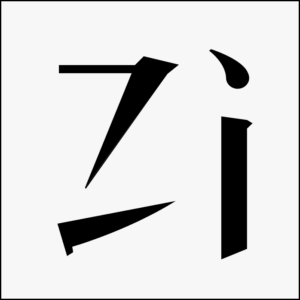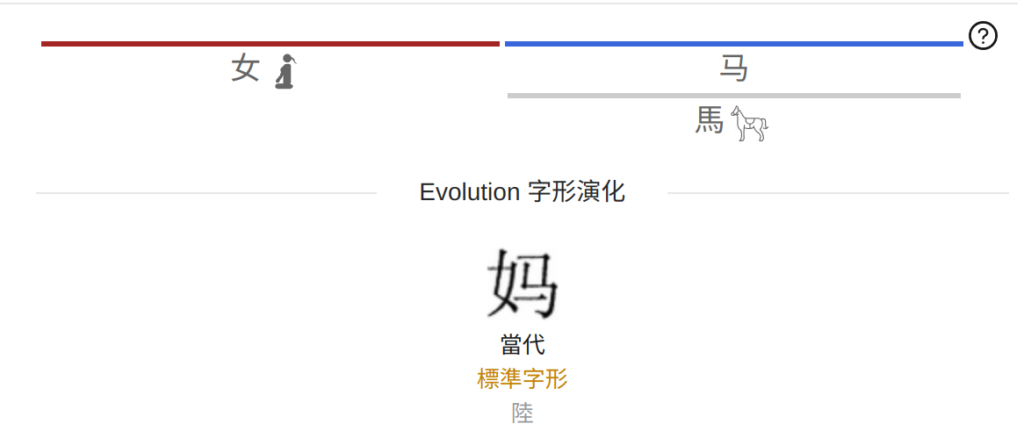 Zi.Tools is a great free resource for exploring Chinese characters. See what it offers and how you can use it to boost your learning!
Zi.Tools is a great free resource for exploring Chinese characters. See what it offers and how you can use it to boost your learning!
Learning about Chinese characters online is both easy and hard at the same time:
- It’s easy because there are many resources that provide information about character components, etymology and much more, completely free.
- It’s hard because most of this information is wrong.
Tune in to the Hacking Chinese Podcast to listen to the related episode (#249):
Available on Apple Podcasts, Spotify, YouTube and many other platforms!
Why most of the information about Chinese characters is wrong
Resources are wrong in many different ways. When it comes to analysing compound characters, many sites simply break characters down automatically into their graphical components.
For example, showing that 木 (mù), “tree”, consists of 十 (shí), “ten”, and 八 (bā), “eight”, which is both wrong and unhelpful (it’s actually a picture of a tree).
Big sheep are not beautiful
When it comes to the origin of characters, there are also a lot of incorrect explanations floating around on the internet. While incorrect explanations can still be helpful if they enable you to memorise a character, it’s always better to at least start with the correct explanation and take it from there.
For example, 美 (měi), “beautiful”, looks like it consists of 羊 (yáng), “sheep” and 大 (dà), “big”, giving rise to common explanations along the line of “big sheep are beautiful”.
However, that’s not how this character came about. Instead, it depicts a person with fancy headgear. The way the top part is written has converged with how we write “sheep” over the centuries, but they are completely unrelated. The bottom part shows a person, which is the origin of 大. We will return to the origin of this character later in this article.
Character etymology: How deep should you dig?
From a learner’s perspective, it’s much less problematic to memorise how to write 美 by visualising a big, fat sheep admiring its own beauty in the mirror than it is to think that 木 consists of 十 and 八. The former has practical value as a mnemonic, but the latter is just bad.
Still, Chinese characters are not arbitrary or random, there is a system there. It’s not a neat system designed by committee once and then left static in its perfection, but it is a system.
So, while it seems innocent to memorise 美 as “big + sheep = beautiful” and it has little cost in the short run, if you always go with folk etymology or incorrect information, you will never learn how characters really work. This doesn’t mean that you always need to use the correct etymology, though, something I’ve discussed in this article: 5 levels of understanding Chinese characters: Superficial forms to deep structure.
5 levels of understanding Chinese characters: Superficial forms to deep structure
Learning Chinese characters becomes easier if you understand the system
Taking shortcuts and making up stories might be okay if you want to learn ten or even a hundred characters, but if you want to learn a thousand and more, learning how that system works is important!
This requires two things: accurate information about characters and direct insight into the system itself. The resource I want to talk about today is great for providing the former. For learning about the system itself, I strongly suggest that you check out the Outlier Chinese Character Masterclass.
Outlier Chinese Character Masterclass review: Understand more, learn faster, remember longer
Zi.Tools: A powerful free resource for exploring Chinese characters
Zi.tools is a powerful online resource for learning about Chinese characters. It draws on many different sources to provide a wealth of information about any Chinese character you might want to look up. While not the easiest to use, it’s by far the best free online resource I know of.
One of the only drawbacks with the site is that it can be a bit chaotic to navigate, so you need to know where to look, and some information is not accessible if you don’t already know Chinese. In this article, I will explain how to extract the information you need!
The Outlier Dictionary of Chinese Characters remains my go-to resource for looking up characters, but that one is neither free nor available online. I will compare it more directly to Zi.tools later in this article.
Please note that Zi.Tools provides in-depth information about individual characters. If you just want to look up what a character means, how it’s pronounced or how it’s used, please refer to a normal dictionary.
Find the Chinese character by searching or composing
Looking up characters works like in any other online dictionary; just type or paste the character in the top bar. If you don’t have the character in a digitised format or can’t type it, you can use the compose (組字) function to combine components to form the character you’re looking for. There is no handwriting input.
Once you’ve found the character, you’ll be presented with much more information than you probably bargained for.
Don’t panic!
We’re going to start by looking up 妈 (mā), “mother”, which you might know already, so this way it will be easier to see how Zi.Tools presents the information you need.
Basic character information on Zi.Tools
First, you’re presented with a visual overview of how the components of the compound contribute to the meaning and sound of the compound itself. Here’s what it looks like for 妈:
So, what does this mean, exactly?
- Components are written out with a small picture next to them. The meaning is not written out, so if you don’t know it, you need to click the component. This is a bit awkward, because you then have to scroll down quite a bit to find what the character means. Using a pop-up dictionary in your browser might be a better option.
- The function of each component is indicated using coloured (red, blue or grey) lines (dotted or solid). I will explain how this works below, but for now, it’s enough to know that blue means a phonetic (sound) component and red indicates a semantic (meaning) component. If you don’t know what this means, you might want to check the series of articles starting here before you continue: The building blocks of Chinese, part 1: Chinese characters and words in a nutshell. Grey means that the character has been transformed from another character, here indicating the traditional character for “horse”, 馬.
- You can see the standard written form of the character. This is displayed as an image to avoid problems with fonts. In the screenshot above, it says 當代 (dāngdài), “contemporary, modern”, 標準字形 (biāozhǔn zìxíng), “standard character form”, and then 陸 (lù), short for 中国大陸 (dàlù), “Mainland China”. If you looked up the traditional version of “mother”, 媽, instead, you would see a whole range of standard forms, including when/where they are/were the standard. For modern usage, look for 當代 (dāngdài), then 台, for 台灣 (táiwān), “Taiwan” or 港 for 香港 (xiānggǎng), “Hong Kong”. Please note that this information is sometimes only displayed in the left sidebar.
The building blocks of Chinese, part 1: Chinese characters and words in a nutshell
Understanding compound characters through coloured lines
Most of the above is pretty straightforward when you know where to look, but the coloured lines require extra explanation. Here’s the one available in the tooltip on Zi.tools:
Here’s the text with my translation:
「會意」 Associative compounds
字形由A與B拼合而來,字義與字音與兩者所拼合字形有關。
The character shape is formed by combining A and B, and its meaning and pronunciation are related to the combined components.
「指事」 Indicatives
B是一個非成字部件,或是一個操作(如減省、旋轉、鏡像等),字義與字音與兩者所拼合字形有關。
B is a non-character component or an operation (such as reduction, rotation, mirroring, etc.), and the meaning and pronunciation are related to the combined components.
「形聲」 Phono-semantic compounds
字義與A有關,字音與B有關。(亦有少部分「形聲兼會意」情況下,字義亦與B有關。)
The meaning is related to A, while the pronunciation is related to B. In some cases of “Phonetic-Semantic with Associative Meaning,” the meaning is also related to B.
「表音」 Phonetic representation
A和B皆為漢字的情況下讀音為它們的切音,或者為兩者讀音的拼合;同時B也可能是一個操作(表音符號,或變形)。
If both A and B are Chinese characters, the pronunciation may be a clipped sound of both or a combination of their sounds. B may also represent an operation, such as a phonetic symbol or transformation.
「訛變」 Corruption
該字是A的變形,音義與A全同。
The character is a variant of A, with the same pronunciation and meaning.
Again, the goal of this article is not to explain how Chinese characters work, so if even the English translations above are new to you, you might want to read the article I linked to earlier or check out Outlier Linguistics’ course.
More useful character information on Zi.Tools
As mentioned, Zi.tools lists much more information than any sane learner will want to know. Feel free to look around to see what attracts your attention, but here are some things that I think are useful and that you might be interested in too:
Origin (字源諸說)
This section explains how the character came about. Note that there are several sources given and that they are not equal. For example, 說文 (short for 說文解字), is almost 2,000 years old and full of inaccuracies, yet many people today still regard it as the ultimate truth when it comes to character explanations.
By comparison, 說文新證 is a modern academic work of palaeography, and thus far more reliable. As the name implies, it also strives to correct many of the errors in 說文.
Here’s what it says about 美, for example (again with my translation):
甲骨文从「大」,上象毛羽飾物,故有美義,羽毛飾物訛變為「羊」形,因此《說文》以為「羊大為美」段註「羊大則肥美」。甲骨文偏旁從「大」都表示正面站立的人形很少用「大」表「大小」之「大」,故說法不可從
The oracle bone script comes from 大 , with the upper part resembling feathered ornaments, which is why it carries the meaning of “beauty”. Over time, the feathered ornament transformed into the shape of 羊, leading 說文 to incorrectly interpret it as “a large sheep is beautiful”, with the annotation stating “a large sheep is fat and beautiful”. In oracle bone script, components derived from 大 typically represent a person standing rather than indicating “big” in size. Therefore, this explanation should not be followed.
An obvious drawback is that these explanations are written in Chinese, but you can always use a pop-up dictionary to aid your reading or use AI to generate a translation.
Evolution (字形演化)
Here you can find earlier forms of the same character. You don’t need to be a paleographer to make use of this information; sometimes just seeing older forms can help. For example, if you look up 美, the fancy headgear is easy to see.
 Calligraphy (後世書法)
Calligraphy (後世書法)
In this section, you can see samples of calligraphy featuring the character in question, including what style of calligraphy it is and who wrote it.
Comparison 用字對比
This section is found in the left sidebar towards the bottom and shows the same character according to different standards. This is great if you’re confused about what variant to use when, or just want to compare different versions. The comparisons often include Japanese and Korean as well. Since it’s not very exciting to compare 美 in different standards, let’s look at 戶 instead:
Too much information about Chinese characters?
As we have seen, Zi.Tools provides a wealth of information about Chinese characters, but I’ve just mentioned a fraction of the information available.
We also have indexing in various character sets, reconstructed Old Chinese, rimes and rime books, entries in various historical dictionaries, kinship diagrams (which rarely make sense, at least to me) and more.
I would go as far as to say that this is too much information, and if you want carefully curated content presented in an easy-to-understand manner, you might want to look elsewhere.
Why you should still get The Outlier Dictionary of Chinese Characters
When I first stumbled upon Zi.Tools, I thought that it would replace Outlier Linguistics’ character dictionary for Pleco, not because it’s more reliable or better, but because it’s online and free to use. I’m a computer person and don’t like using my phone more than I have to.
The more I use Zi.Tools (and I do use it quite a lot), the more I realise that there are significant shortcomings that remind me of the reason Outliers’ dictionary is so useful. Let’s have a look at these shortcomings:
- Explanations in Chinese – This might not be an issue if you can read Chinese already, but then again, your need to look up characters is greatly diminished unless you’re interested in historical texts and the development of the writing system.
- Not aimed at learners – The site is clearly built with native speakers or highly proficient learners in mind. Knowledge about how the writing system works is almost always assumed and rarely explained.
- Too much information – If you don’t know what you’re looking for, Zi.Tools can be annoying to use. Printing the page for 美 would result in a 9-page document, whereas the entry in Outliers’ dictionary is just a few screens on my phone, but still contains everything I need
- Unclear trustworthiness – Since Zi.Tools just lists several explanations of character origins, it’s hard as a learner to know which one to trust. I know that 說文新證 is to be reckoned with mostly because the Outlier guys refer to it a lot. By including everything, the choice of whom to trust falls on you as a learner, and you’re very unlikely to be in a position to judge correctly.
These are both great resources, but suitable for different students in different situations. I’ll keep using them in parallel!
Conclusion: Zi.Tools is a great online resource for learning more about Chinese characters
As should be clear by now, I think that Zi.Tools is a great resource for exploring Chinese characters, by far the best I know that is freely available online. After using it for a while, you’ll know what to look for and what to ignore. For those of you who prefer to use a computer when studying characters or just can’t or don’t want to purchase Outliers’ dictionary, Zi.Tools is a great choice!





1 comments
If you find the etymology or phonetic of a character isn’t helping you memorize it, and you are just in need of a good mnemonic story or image, give my free collection of mnemonics a try (2500+ characters and growing)! https://www.chinesecharactercoach.com/learners-dictionary